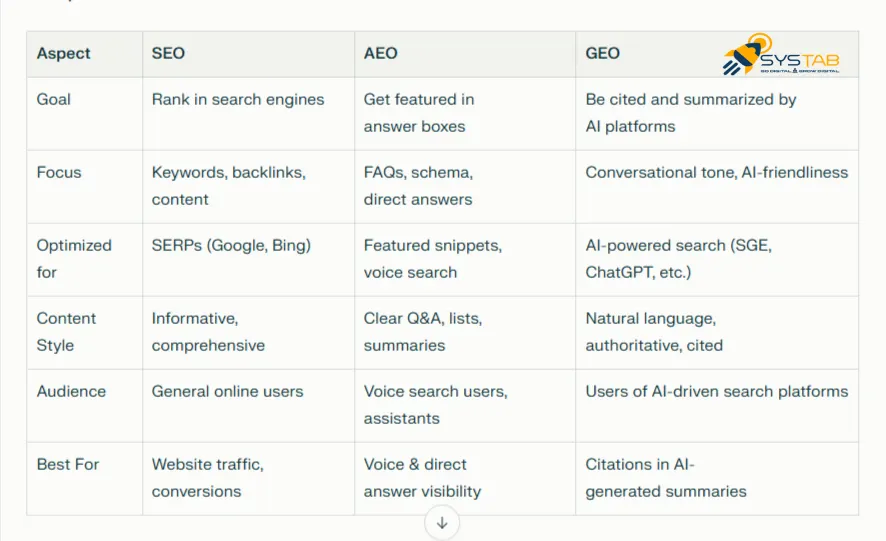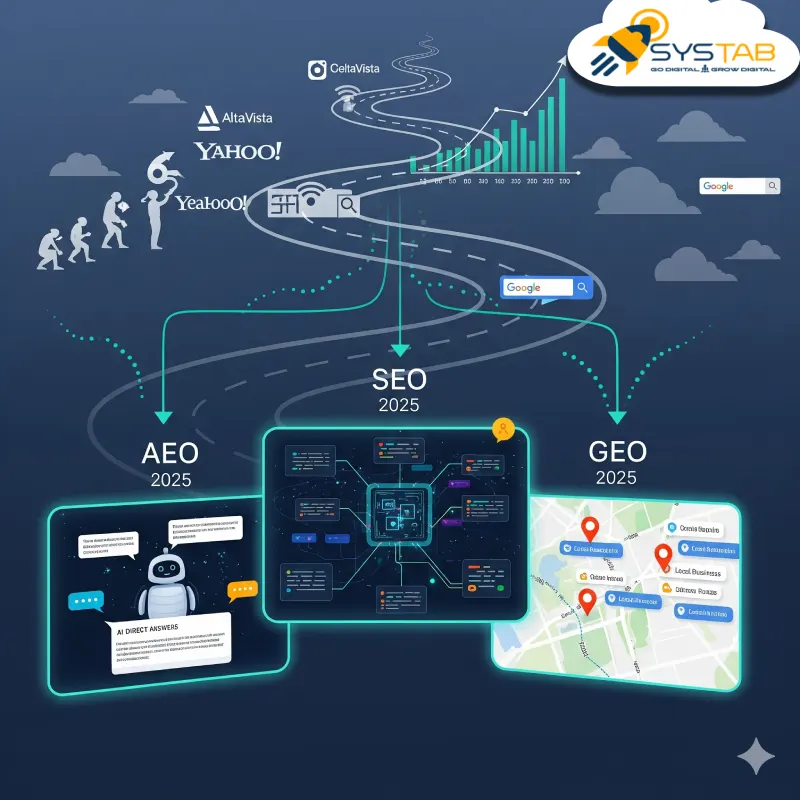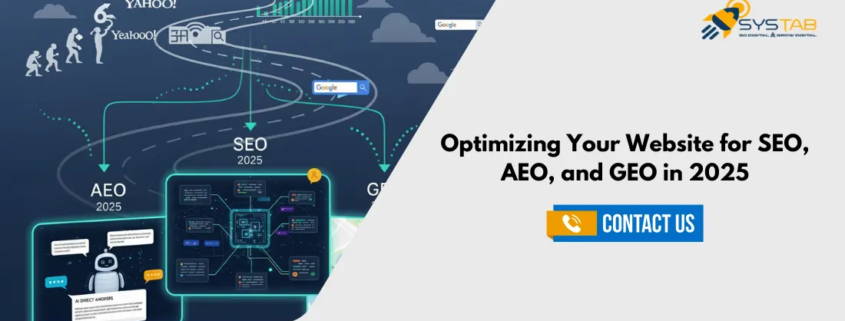Let’s get interactive and real—because optimizing your site for SEO, AEO, and GEO in 2025 isn’t just about ticking checkboxes, it’s about creating content that’s found, featured, and cited everywhere online. Settle in for a data-driven, step-by-step walkthrough with practical, real-world examples. This guide is built for both beginners and seasoned marketers, packed with actionable insights and the latest stats.
Why Modern Search Optimization Needs a Triple-Threat Approach
Just a few years ago, “doing SEO” meant stuffing a few keywords and hoping Google would send you traffic. Not anymore.
Now, your content needs to:
- Rank in traditional search (SEO)
- Answer direct questions and appear in snippets/voice assistants (AEO)
- Get cited, summarized, and trusted in AI-powered engines like ChatGPT, Gemini, and Copilot (GEO)
Here’s the kicker: 46% of Google searches have local intent, “near me” queries are up 500% since last year, and over 8.4 billion voice assistants are in use globally. Meanwhile, a growing segment of user journeys never click through to your website—they find their answer right in an AI-generated summary, or a Google snippet. If your content isn’t optimized for these new realities, you’re invisible to a huge portion of your audience.
Let’s get hands-on and walk through the exact steps you need to thrive.
Real-World Proof: Stats and Performance
- 98% of searchers pick a business from page one results—SEO still matters.
- Businesses with updated Google Business profiles show up 70% more often in local queries.
- Pages with FAQ schema get pulled into snippets at a rate 2x higher than plain-text content.
- Sites cited by AI models (SGE, ChatGPT) see a 25–40% lift in brand searches and long-tail traffic in 6–12 weeks.
- NAP consistency issues can cause 25% of local searches to return incorrect results—track this across platforms.

SEO: The Solid Foundation for Visibility and Traffic
SEO is like the roots of a tree—without it, nothing else can grow. It’s still crucial, but it’s evolved.
Step 1: Keyword Research that’s Smarter—and More Local
- Grab tools like Google Keyword Planner, SEMrush, Ahrefs, or AnswerThePublic.
- Look for keywords with growing trends, including local intent (“best vegan pizza in kolkata”) and question-based phrases (“How do I choose hiking boots?”).
What’s New in 2025?
- Pay attention to “micro-moment” searches—these short, specific queries often asked on mobile or voice, e.g., “Open late barbecue near me.”
- Don’t just guess. Use Google Trends to spot seasonal spikes (“snow tires Manali” in November!).
Example:
Suppose you run a sneaker shop. Here’s your funnel:
- High-volume keyword: “best running shoes 2025”
- Local: “running shoes in Bengaluru Koramangala”
- FAQ-style: “Are carbon-plated sneakers worth it?”
Mix general and ultra-local terms to capture all types of traffic.
Step 2: On-Page Optimization (Modernized)
- Primary keyword in the page title, H1, meta description, and first 100 words.
- Use related keywords (“marathon shoes,” “trail running”) naturally.
- Optimize images (ALT tags: “lightweight running shoe for marathons”).
- Use internal links to spread authority (“See our guide on foot types”).
Example:
A blog post titled “Best Running Shoes for Flat Feet: 2025 Guide” should use:
- Clear, simple headings (“Types of Support for Flat Feet”),
- Concise paragraphs,
- ALT text (“motion-control sneaker for flat arches”).
Step 3: Technical SEO—Don’t Lose Out on Speed, Security or Usability
- Site loads in less than2 seconds. Compress images, use lazy loading.
- HTTPS everywhere (Google flags insecure sites).
- Responsive (mobile-friendly) design. Mobile-first indexing now powers the majority of search.
Pro tip:
Use Google PageSpeed Insights and Mobile-Friendly Test tools regularly. Fix errors quickly.
Step 4: Build Authority and Trust
- Obtain quality backlinks from respected sources. Guest posts, industry interviews, and local features all help.
- Create shareable assets—infographics (“Top Shoe Technologies in 2025”) or calculators (“Find Your Perfect Running Shoe”).
Data Point:
Sites with 40+ quality backlinks rank 20% higher on average than competitors with fewer links.

AEO: Getting Into the Head—and Voice—of the Searcher
Answer Engine Optimization is all about appearing where users get answers instantly: featured snippets, voice search, smart assistants.
Step 1: Structure Content for Direct Answers and Snippets
- Add a FAQ section to every product, service, or informational page.
- Write answers succinctly—30–50 words.
- Format with bullet points, numbered lists, and one-sentence summaries.
Example:
A section titled “Frequently Asked Questions about Sneakers”:
- Q: “What type of running shoe is best for flat feet?”
- A: “Motion-control shoes support flat feet with extra arch reinforcement.”
Mark the FAQ with FAQPage schema so Google, Siri, and Alexa find it easily.
Step 2: Implement Schema Markup Everywhere
- Use Google’s Structured Data Markup Helper or plugins (e.g., RankMath, Yoast).
- For FAQs, apply FAQPage schema; for tutorials, use HowTo schema.
- Validate with Google’s Rich Results Test.
Why Schema Matters:
Pages with rich schema see up to a 25% increase in click-through rates and visibility in “People Also Ask”.
Step 3: Conversational, Human-First Copy for Voice and AI
- Write how people actually speak, not robot sentences.
- Use genuine questions and direct answers.
- Avoid jargon—imagine explaining to a friend. “Hey, what’s the difference between road and trail shoes?”
Voice Search Optimization:
- Natural, conversational questions (“Which running shoes are best for rainy weather?”).
- Avoid long, compound sentences.
Step 4: Content Formats for Featured Snippets and Quick Answers
- Use tables, summary boxes, comparison charts where relevant.
- “How-to” guides formatted as step-by-step bullet lists.
Example:
“How do you clean white sneakers?”
- Remove laces.
- Mix soap and warm water.
- Scrub gently with a soft brush.
- Air dry.
Google loves answers like this for snippets and voice results.
Step 5: Monitor and Refine
- Use tools like SEMrush, Ahrefs, and AlsoAsked.com to see which questions appear in People Also Ask.
- Update your FAQ and conversational answers every month—snippets rotate frequently.
GEO: Optimizing for AI-Powered Engines & Future-Proofing Your Content
Generative Engine Optimization (GEO) is the newest frontier: making sure AI models (Gemini, ChatGPT, Bing Copilot) understand, cite, and recommend your content—even when users never click through.
Step 1: Make Your Content AI-Reference Friendly
- Produce long-form guides (1,500–3,000 words) that cover topics comprehensively.
- Include fact-checked data, statistics, expert quotes, and summaries.
- Reference reputable sources—link (and cite) studies, authoritative organizations, and industry benchmarks.
Example:
“2025 Guide to Running Shoes: Trends, Technologies, and Buying Tips”—covers every aspect: materials, brands, fitting, local stores, research, and athlete testimonials.
AI engines are trained to surface authoritative, well-cited content for summary answers.
Step 2: Add Author Bios and Establish Expertise
- Every guide or expert piece should include an author bio with credentials.
- “Written by Jane Smith, Marathon Trainer & Sports Science Writer (10 years’ experience)”
- List awards, mentions, testimonials, and credentials directly in-page.
Data Point:
Content with named author bios is 40% more likely to be cited by generative engines.
Step 3: Use Trust Signals, Citations, and “Entity” Clarity
- Cite facts (“According to the American Podiatric Medical Association…”).
- Use trustworthy outbound links to respected publications.
- Explain who you are, what you do, and where you’re based—this helps AI understand your “entity” (brand).
Step 4: Implement and Test Schema for Location, Reviews, and Entities
- Use LocalBusiness, GeoCoordinates, Review, and Organization schema.
- Add consistent NAP (Name, Address, Phone) info across your website, Google Business Profile, and directories.
- Use local references (“Best running shoes in Indiranagar, Bengaluru, near Purple Line Metro”).
Example:
Your local page “Plumbing Services in Scottsdale, AZ” includes:
- Q&A section
- Reviews marked up as Review schema
- LocalBusiness schema
- Local landmarks in copy
Google, Gemini, and ChatGPT will pull validated, specific information and cite it in direct answers to user questions.
Step 5: Make Content Easy for AI to Parse and Summarize
- Use clear headings, subheadings, and summary sections.
- Avoid complex formatting—keep tables and lists simple.
- Place summaries (“In short…”) at the top for fast scanning by AI.
Pro tip:
Google’s Search Generative Experience (SGE) and AI engines now reward “clarity, context, and cited expertise”—not just keyword density.
Integrated Example Workflow: From SEO to AEO to GEO
Let’s walk through one practical scenario, step by step.
Suppose You Run a Local Plumbing Service in Scottsdale, AZ
Step 1: SEO Foundation
- Publish blog: “Top Plumbing Tips for Scottsdale Homeowners in 2025.”
- Use location and seasonal keywords: “monsoon pipe repair Scottsdale,” “Scottsdale emergency plumber.”
Step 2: AEO Enhancements
- Add FAQ: “How quickly can a plumber arrive in Scottsdale?” “What services are covered under emergency repair?”
- Mark up with FAQPage Schema.
- Write concise answers—ideal for snippets and voice.
Step 3: GEO Optimization
- Claim Google Business Profile. Update location, hours, and services.
- Feature reviews on landing pages (with Review schema).
- Cite authority: “Based on data from Scottsdale Home Services…”
- Add local references (“near Old Town Scottsdale”).
Step 4: Ready for AI Engines
- Content is structured, cited, well-reviewed, and location-rich.
- Gemini, ChatGPT, and Google SGE can confidently cite your page when users ask, “Best emergency plumber in Scottsdale.”
Data Point:
28% of local voice searches lead to a buying decision or store visit within 24 hours—so nailing local + AI visibility can directly boost your business.
Tools & Dashboards to Power Your Optimization
The right tools make this process far easier.
- SEO Ranking & Monitoring: SEMrush, Ahrefs, Google Search Console
- Schema Markup: Merkle Schema Markup Generator, RankRanger Schema Builder
- Local Tracking: Moz Local, Yext, BrightLocal (for NAP consistency, reviews, directories)
- AI Content Creation: ChatGPT, SurferSEO, Jasper
- People Also Ask Discovery: AlsoAsked.com, AnswerThePublic
“Tracking your performance is crucial: SEO sessions, AEO snippet/impression rates, GEO monthly AI citations—monitor and refine each area separately for maximum results.”
Strategies and Tactics for Different Business Models
E-commerce
- SEO: Emphasize product categories, reviews, buying guides
- AEO: Answer quick product questions, shipping info, size guides with FAQ and schema
- GEO: Long-form buying guides, authoritative reviews, expertise citations
Local Business
- SEO: Location keywords, directory listings, Google Business Profile
- AEO: Local FAQs, mapped schema, quick directions/services
- GEO: Rich reviews, testimonials, neighborhood references, consistent NAP
B2B and Information Sites
- SEO: Authority-building, comprehensive guides
- AEO: Q&A for decision-makers, schema for services, pricing, onboarding
- GEO: Expertise highlights, cited whitepapers, interview-based articles
Frequently Asked Questions (Based on People Also Ask Data)
Q: Does GEO replace traditional SEO?
A: No—GEO enhances SEO by making your content AI-citable and authoritative. You need traditional SEO as the foundation; GEO optimizes for the new AI paradigm.
Q: How do I optimize for AI-powered search engines?
A: Create comprehensive, clearly structured, and cited content with rich schema markup. Make it easy for AI to extract and summarize your best answers—use lists, summaries, and names/locations consistently across all platforms.
Q: Should I combine SEO, AEO, and GEO?
A: Yes! The most visible brands integrate all three. SEO brings steady traffic, AEO secures voice/snippet impressions, GEO drives citations and authority in AI platforms. Together, they maximize total online visibility.
Q: What content formats work best for GEO?
A: Long-form guides, FAQ sections with schema, summary boxes, and testimonials. Include clear sources and author bios.
Q: Is GEO relevant for local businesses?
A: Absolutely. AI engines constantly pull local data, reviews, and NAP signals. If you want your business cited in voice and generative search, GEO is essential—even for hyperlocal shops.
Beyond 2025: The Future—Voice, Multimodal, and AI Everywhere
SEO, AEO, and GEO are converging. Search engines and AI will soon understand images, location data, voice, and gestures. AR/VR will drive local business visits. Multilingual and culturally-contextual results will dominate, especially on mobile and wearable devices.
If you want to truly future-proof your site:
- Build content that’s global and local—consider different languages and customs.
- Invest in multimodal schema—embed audio, video, and geolocation data.
- Track new “search surfaces”—voice apps, smart TVs, wearables.
Your Personalized Optimization Checklist
Weekly
- Update FAQ sections with new questions and answers.
- Validate schema markup and fix errors using Google Rich Results Test.
- Analyze AI citations—where is your content being referenced?
Monthly
- Review NAP consistency on Google, directories, social media.
- Add fresh reviews and testimonials.
- Publish at least one authoritative, cited guide—optimizing for GEO.
Quarterly
- Deep dive into your rankings, AI impressions, and snippet appearances.
- Test voice search queries for accuracy and local presence.
- Check competitor visibility in AI engines—and adapt.
Final Takeaways—Action Steps, Not Just Theory
SEO, AEO, and GEO are not enemies—they’re teammates. Today’s search is everywhere: blue links, snippets, direct answers, AI summaries. Master all three and your content will be everywhere your users are looking.
You don’t need a huge team to get started. Grab the tools, follow each step, and measure your results. Every improvement is a step up the visibility ladder.
- Begin with strong SEO fundamentals.
- Layer in AEO for answer boxes and voice.
- Future-proof with GEO: make your content irresistible for AI engines.


